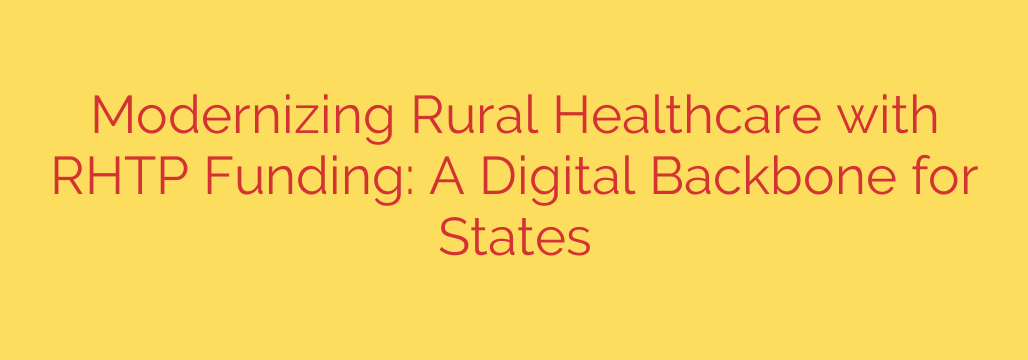
How a Digital Backbone is Revolutionizing Rural Healthcare
For decades, a significant gap has existed between urban and rural healthcare. Residents of rural communities often face immense challenges, from long travel times to a scarcity of specialist doctors. However, a new wave of modernization, powered by strategic funding and technology, is creating a “digital backbone” to bridge this divide and deliver high-quality care to every corner of the nation.
This digital transformation is about more than just faster internet. It’s about building a connected, intelligent, and secure health infrastructure that empowers providers, engages patients, and ultimately saves lives.
What is a Healthcare Digital Backbone?
Think of a digital backbone as the central nervous system of a state’s healthcare system. It’s an integrated network of technologies and data-sharing protocols that allows information to flow seamlessly and securely between different healthcare entities.
Key components of this infrastructure include:
- Health Information Exchanges (HIEs): Secure networks that allow doctors, nurses, hospitals, and other providers to safely access and share a patient’s vital medical information electronically.
- Robust Telehealth Platforms: High-quality, reliable video and communication tools that enable virtual consultations, remote patient monitoring, and specialist access from anywhere.
- Interoperable Electronic Health Records (EHRs): Ensuring that patient records from a small rural clinic can be read and understood by a large urban hospital, eliminating data silos and improving care coordination.
- Secure Data Analytics and Reporting Tools: Systems that help public health officials track disease outbreaks, manage population health trends, and allocate resources more effectively.
By connecting disparate parts of the healthcare ecosystem, this digital backbone ensures that a patient’s crucial health data is available at the right time, to the right provider, regardless of their physical location.
The Critical Role of Federal Funding for Modernization
Building this sophisticated infrastructure requires significant investment, which is often a major barrier for states and rural providers. This is where programs like the Rural Health Transformation Program (RHTP) and similar federal grants become game-changers.
This dedicated funding is designed specifically to help states overcome the financial hurdles of modernization. It provides the capital necessary to:
- Implement or upgrade statewide HIEs.
- Help smaller, independent rural clinics adopt modern EHR systems.
- Expand broadband access and telehealth capabilities in underserved areas.
- Invest in the cybersecurity infrastructure needed to protect sensitive patient data.
This strategic investment is not just a handout; it’s a catalyst for creating a self-sustaining, efficient, and equitable healthcare system for the future. States that successfully leverage this funding can build a permanent digital infrastructure that will benefit their residents for years to come.
Actionable Steps for Building a Resilient Digital Health Strategy
For state leaders and healthcare organizations looking to build a successful digital backbone, a clear strategy is essential. Success hinges on more than just technology; it requires a focus on people, processes, and security.
1. Foster Public-Private Partnerships
No single entity can build this alone. States must collaborate with technology vendors, healthcare providers, public health agencies, and local community leaders. Strong partnerships ensure that the technology meets real-world needs and fosters widespread adoption.
2. Prioritize Interoperability from Day One
It’s crucial to adopt and enforce common data standards across all systems. Without true interoperability, you are just creating more sophisticated data silos. The goal is a unified system where a patient’s journey is seamless, from their local primary care doctor to a specialist hundreds of miles away.
3. Implement Ironclad Cybersecurity Measures
As healthcare becomes more connected, the risk of cyberattacks increases. Protecting patient data is paramount. A robust security strategy must include:
- Strict adherence to HIPAA compliance regulations.
- Continuous network monitoring to detect and respond to threats in real-time.
- Regular security training for all healthcare staff.
- Secure data encryption both at rest and in transit.
4. Invest in Digital Literacy and Training
The most advanced technology is useless if providers and patients don’t know how to use it. Comprehensive training programs are essential for both clinicians and community members to ensure they are comfortable and proficient with new telehealth platforms, patient portals, and other digital tools.
The Future is Connected
The modernization of rural healthcare is no longer a distant dream. By leveraging dedicated funding to build a robust digital backbone, states can eliminate longstanding disparities in care. The result is a more resilient, efficient, and patient-centric healthcare ecosystem where your zip code no longer determines your health outcome. This connected future promises better health outcomes, lower systemic costs, and a stronger, healthier rural America.
Source: https://feedpress.me/link/23532/17175944/building-a-digital-backbone-how-states-can-modernize-rural-healthcare-with-rhtp-funding







